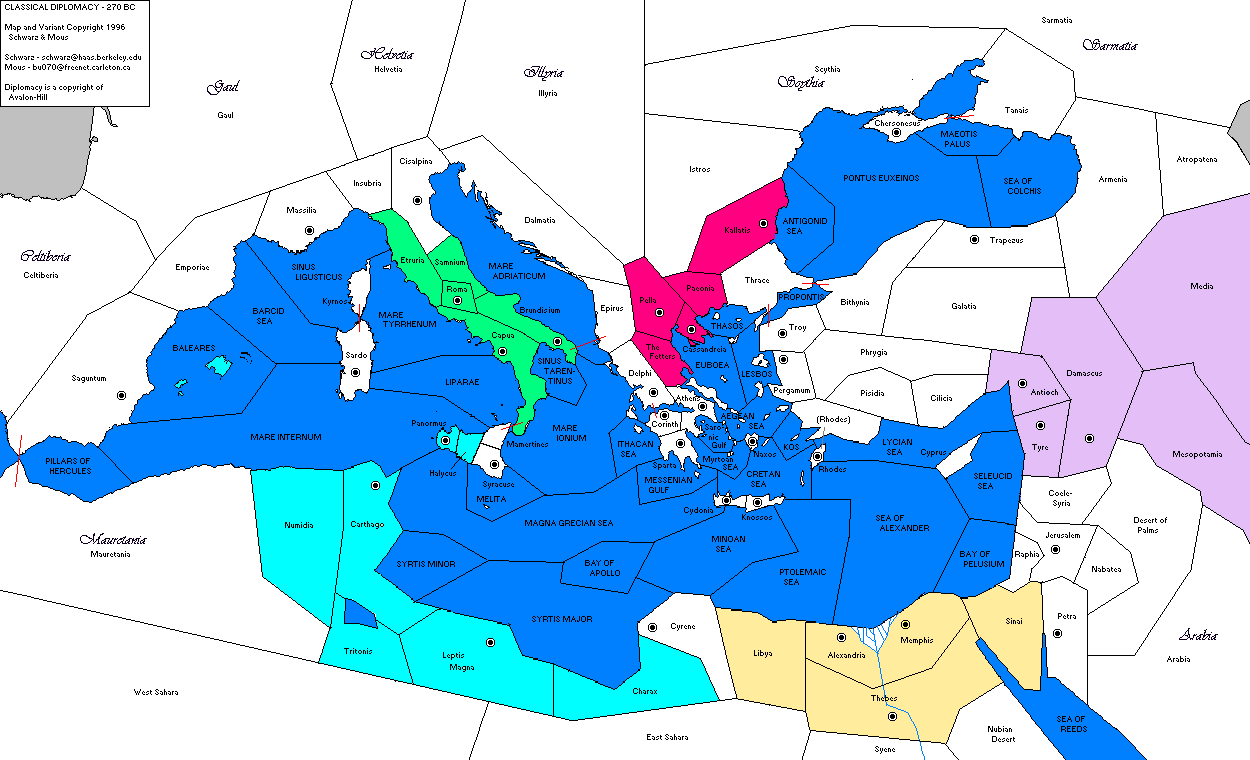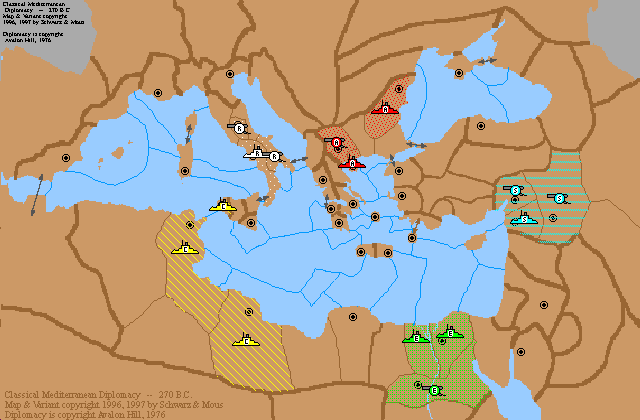Classical
Created by: Andy Schwarz and Vincent Mous
Variant Description:
1) The rules of "standard" Diplomacy are valid, unless specifically
replaced or amended by these rules
2) All references in the "standard" rules to specific powers,
provinces, locations, and seasons do not apply to "Classical."
The standard map is replaced by the "Classical" variant map.
3) The game begins in Spring 273 B.C. Because years before 1 A.D. count
backwards, Spring 273 B.C. is followed by Fall 273 B.C., Winter 273
B.C., and then Spring 272 B.C. However, for the purposes of Judge
play, the game is counted in years since the death of Alexander the
Great (to allow time to move forward and fit the Judge program). Thus
273 B.C. is noted as Year 50, and 272 B.C. is Year 51, etc.
4) There are 35 supply centers on the board. The winner is the power
which holds 18 or more supply centers during an adjustment phase.
5) There are 5 great powers. The starting units are as follows:
A-MACEDON A Pella F Cassandreia F Kallatis
C-CARTHAGE F Carthage F Panormus F Leptis Magna
E-EGYPT A Thebes F Alexandria F Memphis
R-ROME A Brundisium A Roma F Cumae
S-SYRIA A Antioch A Damascus F Tyre
- Please note that MACEDON is abbreviated with an "A" to avoid
conflict with the MASTER of the game. ***
6) A power may build in any vacant supply center it owns during an
adjustment phase, assuming at least one of the original SCs of that
power is owned by that power: thus while there are permanent "home
centers," as long as you own one, all owned centers act like home
centers. For example, Carthage may build in Syracuse if (1) it is
vacant, (2) Carthage owns it and (3) Carthage is eligible for a build
and (4) Carthage still owns at least one of: Panormus, Carthage, or
Leptis Magna.
SPECIAL MAP FEATURES:
7) All Coastal provinces are assumed to have only one coast. Thus, for
example, a fleet can enter Athens from Euboea and exit to Corinth
the following turn. The same holds for Fleets entering Sinai from
Memphis and proceeding to Petra (and vice versa), and for Agrigentum as
well.
Note, however, that two neighboring coastal provinces, may not
necessarily be adjacent for the purposes of sea travel. For example.
Etruria and Cisalpina are both coastal provinces, but they do not touch
on a water border, and thus a fleet in Etruria may not move to
Cisalpina or vice versa.
7a) The Nile is navigable up to Thebes. Once in Thebes, a fleet may move
to the Sinai, Sea of Reeds, or Nubian Desert via "portage" (this is
just a regular move order. i.e. a "portage" from Thebes to Nubian
Desert is just F Thebes- Nubian Desert, with no special indication
that the fleet may have had to be lifted across a stretch of desert)
Note, however, F Thebes cannot move to Libya, for the same reasons
that F Cis-Etr is not allowed.
7b) The Rhodes space in southeastern Asia Minor consists of the island of
Rhodes proper and the mainland province of Caria which Rhodes
controlled. They are one province despite being separated by water.
Thus, for example, a unit entering Rhodes from the Sea of Alexander
may move to Pergamum in the following season (and vice versa). Note
however, that the Lycian Sea and the Cretan Sea ARE adjacent (as are
Lycian and Kos), despite this unusual land province.
8) The games has several land bridges, designed to improve interaction
among the five powers. These connect the following land provinces:
- Mauretania Saguntum
- Kyrnos Sardo
- Cumae Mamertines
- Brundisium Epirus
- Bithynia Thrace
- Thrace Troy
- Chersonesus Tanais
- Corinth Delphi
Note that Rhodes also has a land bridge indicated, but its
special nature is defined by rule 7b above.
8a) Units (army or fleet) in a province with a land bridge may move to
the opposite shore at full strength. In addition, a unit in such a
province may give support to a unit on the other side, or support a
move into the space across the bridge, also at full strength,
regardless of the presence of a fleet in the waters between the land
bridges.
Examples:
R: Brundisium-Epirus. A: Pella-Epirus. result: both bounce.
R: Dalmatia-Epirus, Brundisium s Dalmatia-Epirus. A: Pella-Epirus. result: Dalmatia-Epirus succeeds.
R: Brundisium S Epirus, Epirus H. A: Pella-Epirus, Delphi S Pella-Epirus. result: Epirus holds, Pella bounces.
8b) None of these land bridges precludes movement across the sea spaces
they cross. For example, an army moving from Thrace to Troy will not
impede a fleet moving from Propontis to Lesbos. In addition, these
land bridges do not prevent convoys, so an army in Bithynia may convoy
via Propontis and Lesbos to Pergamum, or even, should the need arise,
directly across the Propontis to Thrace (this might be used to swap two
units which would otherwise bounce).
9) Generally, land locations can be abbreviated by the first three
letters. The one exception is Sarmatia, abbreviated as Srm to avoid a
conflicts with Sardo, Sar. Ignore the word "The" when abbreviating.
Sea space abbreviations are a bit more complicated. Three-word sea
spaces, like Bay of Pelusium and the Magna Grecian Sea are abbreviated
by their initials, e.g., BoP and MGS. Sea spaces beginning with Sinus
are abbreviated S plus the first two letters of the second word,
e.g., Sinus Ligusticum is abbreviated SLi. Similarly, sea spaces
beginning with Mare are abbreviated M plus the first two letters of the
second word, e.g., Mare Adriaticum is abbreviated MAd. Other Sea
Spaces are abbreviated by the first two letters of their first name and
S, such as Antigonid Sea (AnS) or Messenian Gulf (MeG). In a few
cases, such as Maeotis Palus, the first three letters will suffice
(Mae). Finally, the Syrtis Major and Syrtis Minor are abbreviated SMa
and SMi respectively.
Please note these abbreviations:
Mare Internum MIn Minoan Sea MiS Antioch Ant Antigonid Sea AnS Sardo Sar Sarmatia Srm Syrtis Major SMa Syrtis Minor SMi Barcid Sea BaS Baleares Bal The Fetters Fet The Mamertines Mam
Historical Background:
Typically, the history of the ancient Mediterranean is written in two
halves, a Greek and Roman split, with events in Greece taking center-stage
until the death of Alexander the Great in 323 B.C. Then the focus shifts
west. First we head backwards in time to the early days of Rome. The
narrative pushes forward to the last decades of the 4th century B.C. again,
to the point of Alexander's death, when the Romans take on the Samnites for
control of the Italian peninsula south of the Po.
Soon after the Roman victory over Samnium, Carthage looms as a rival to
Rome and the next hundred years or so are spent on the three Punic Wars,
with passing discussion of things Greek. Mention is made here and there
of the "Diadochi" (Successor) Kingdoms formed by Alexander's generals in
Macedon, Egypt and Syria, for example when Macedon allies with Carthage
during the second Punic War, or when Egypt chooses neutrality throughout.
But for the most part, general histories act as if the Greek world stood
still and waited for Rome to come calling, whereupon these corrupt kingdoms
succumbed, one by one, to the virile power of the Roman Republic. Or so
some of the more pro-Roman historians would have us believe. Conveniently,
at about the time of the shift to Imperial rule, Rome has managed to
conquer the Hellenistic east and the history of these eastern kingdoms is
taken up again, now as part of Imperial Rome.
But in 323 B.C., when Alexander died in Babylon, he was preparing (among
many things) to sail west and conquer Sicily. His death, and the
subsequent wars dividing Alexander's legacy left the Sicilian Greeks
independent until Rome and Carthage contested control, starting in 264
B.C.. But in 273 B.C, nine years before the First Punic War broke out, Rome
and Egypt formed an alliance of friendship, partially out of fear of a
Carthaginian-Syrian pact. In theory, Carthage and Rome were allied as well
against the threat from Syracuse and Epirus. And thus the 3 way eastern
struggle and the one-on-one between Carthage and Rome can be seen as a five-
way struggle for power in a single Classical Mediterranean world, breaking
away from the traditional approach to classical history, and considering
whether more aggressive intervention from the East might have thwarted Rome
before the defeat of Carthage.
Case in point: in 282, Rome went to war with Taras (Tarentum in Latin,
modern day Taranto), a Greek city-state in the "in step" of the Italian
boot. The Romans had entered the "Sinus Tarentinus" in violation of a
treaty with Taras, and in response, Taras declared war and asked King
Pyrrhus of Epirus, a relative of Alexander the Great (on his mother's
side), to serve as general. Pyrrhus (aided by various Greek leaders)
invaded Italy with a professional army using Macedonian phalanx tactics.
With a much smaller army, Pyrrhus managed to defeat the Romans at Heraclea.
Had Pyrrhus had more strength to follow up on this and the subsequent
victory at Ausculum, perhaps Rome would have become part of the periphery
of states around the Hellenistic kingdoms, rather than the eventual master.
Instead, with his eponymous pyrrhic victory, Pyrrhus was worn down and
eventually left Greek Italy to its Roman fate.
Classical Diplomacy is set in 273 B.C, 50 years after the death of
Alexander the Great. This is just after the Romans have secured control of
all of Italy south of the Po, and in the very year in which Rome and Egypt
signed their first pact of friendship. Carthage, which rules the major
western Mediterranean islands, southern Spain and northern Africa, is still
nominally Rome's ally, having joined to fight the common enemy of Pyrrhus.
Carthage and Greece share a long history of trade relations.
After 50 years of struggle, the successor states to Alexander have hammered
out a compromise of coexistence: Macedon is to be ruled by the family of
Demetrius Poliorcetes (City-Conqueror), son of Antigonus Monopthalmus
(One-Eyed), one of Alexander's generals. Egypt remains in the hands of the
House of Ptolemy (another of Alexander's generals), and the vast lands
formerly ruled by the Persians from Asia Minor to the Indus Valley, fall to
The House of Seleucus, yet another Alexandrine general (Seleucus was
Alexander's cavalry commander).
The city-states of Greece and western Asia Minor, who chafed under
Macedonian rule, have broken free into autonomous leagues. The Greek
colonies in Sicily and at the far reaches of the Black Sea and Western
Mediterranean remain free. But they are kept safe only by the mutual
jealousy of their larger neighbors, none of whom wish to yield to another
in fear of being out-positioned.
Five well-balanced powers face each other across the Mediterranean. Can
you manipulate your allies and crush your foes to control the known world?
The Classical Mediterranean Diplomacy variant follows the most of
the rules as standard Diplomacy with a modified map. The game was designed
to allow a balanced, yet asymmetric five-player variant for the same level
of intrigue and interaction as standard Diplomacy when 7 players aren't
available.
The variant was designed by Vincent Mous and Andy Schwarz. Playtesters and
kibitzers included Benjamin Winkler, Charlie Eldred, Toby Tyrrell, Eric
Coffey, Nate Kaiser, Jon Fetter, Manus Hand and Nate Johnson, David Schmid,
Wes Makin, Eric Person, James Mixon, Brian Burkhart, Paul Ang, and John
Quarto von Tivador. Many more people helped bring this game to reality,
and special thanks should be given to Kevin Roust and David Norman for
their tireless efforts.

